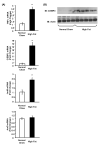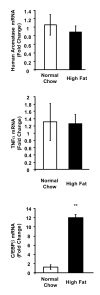Weight gain increases human aromatase expression in mammary gland
- PMID: 22342815
- PMCID: PMC3312968
- DOI: 10.1016/j.mce.2012.01.027
Weight gain increases human aromatase expression in mammary gland
Abstract
Adulthood weight gain predicts estrogen receptor-positive breast cancer. Because local estrogen excess in the breast likely contributes to cancer development, and aromatase is the key enzyme in estrogen biosynthesis, we investigated the role of local aromatase expression in weight gain-associated breast cancer risk in a humanized aromatase (Arom(hum)) mouse model containing the coding region and the 5'-regulatory region of the human aromatase gene. Compared with littermates on normal chow, female Arom(hum) mice on a high fat diet gained more weight, and had a larger mammary gland mass with elevated total human aromatase mRNA levels via promoters I.4 and II associated with increased levels of their regulators TNFα and C/EBPβ. There was no difference in total human aromatase mRNA levels in gonadal white adipose tissue. Our data suggest that diet-induced weight gain preferentially stimulates local aromatase expression in the breast, which may lead to local estrogen excess and breast cancer risk.
Copyright © 2012 Elsevier Ireland Ltd. All rights reserved.
Figures





Similar articles
-
A humanized pattern of aromatase expression is associated with mammary hyperplasia in mice.Endocrinology. 2012 Jun;153(6):2701-13. doi: 10.1210/en.2011-1761. Epub 2012 Apr 16. Endocrinology. 2012. PMID: 22508516 Free PMC article.
-
Estrogen Protects against Obesity-Induced Mammary Gland Inflammation in Mice.Cancer Prev Res (Phila). 2015 Aug;8(8):751-9. doi: 10.1158/1940-6207.CAPR-15-0082. Epub 2015 Jun 2. Cancer Prev Res (Phila). 2015. PMID: 26038116 Free PMC article.
-
Malignant breast epithelial cells stimulate aromatase expression via promoter II in human adipose fibroblasts: an epithelial-stromal interaction in breast tumors mediated by CCAAT/enhancer binding protein beta.Cancer Res. 2001 Mar 1;61(5):2328-34. Cancer Res. 2001. PMID: 11280806
-
The human CYP19 (aromatase P450) gene: update on physiologic roles and genomic organization of promoters.J Steroid Biochem Mol Biol. 2003 Sep;86(3-5):219-24. doi: 10.1016/s0960-0760(03)00359-5. J Steroid Biochem Mol Biol. 2003. PMID: 14623514 Review.
-
Transcriptional control of local estrogen formation by aromatase in the breast.J Steroid Biochem Mol Biol. 2015 Jan;145:179-86. doi: 10.1016/j.jsbmb.2014.05.004. Epub 2014 May 17. J Steroid Biochem Mol Biol. 2015. PMID: 24846828 Review.
Cited by
-
Obesity-Associated Breast Cancer: Analysis of Risk Factors and Current Clinical Evaluation.Adv Exp Med Biol. 2024;1460:767-819. doi: 10.1007/978-3-031-63657-8_26. Adv Exp Med Biol. 2024. PMID: 39287872 Review.
-
Aromatase expression and regulation in breast and endometrial cancer.J Mol Endocrinol. 2016 Jul;57(1):R19-33. doi: 10.1530/JME-15-0310. Epub 2016 Apr 11. J Mol Endocrinol. 2016. PMID: 27067638 Free PMC article. Review.
-
Calorie intake, olive oil consumption and mammographic density among Spanish women.Int J Cancer. 2014 Apr 15;134(8):1916-25. doi: 10.1002/ijc.28513. Epub 2013 Oct 23. Int J Cancer. 2014. PMID: 24254818 Free PMC article.
-
The discrepancy of aromatase expression in epicardial adipose tissue between CHD and non-CHD patients.Cardiovasc J Afr. 2021 Jul-Aug 23;32(4):204-207. doi: 10.5830/CVJA-2021-012. Epub 2021 Jun 7. Cardiovasc J Afr. 2021. PMID: 34128950 Free PMC article.
-
Adult weight gain, fat distribution and mammographic density in Spanish pre- and post-menopausal women (DDM-Spain).Breast Cancer Res Treat. 2012 Jul;134(2):823-38. doi: 10.1007/s10549-012-2108-3. Epub 2012 Jun 12. Breast Cancer Res Treat. 2012. PMID: 22689088 Free PMC article.
References
-
- Anderson GL, Limacher M, Assaf AR, Bassford T, Beresford SA, Black H, Bonds D, Brunner R, Brzyski R, Caan B, Chlebowski R, Curb D, Gass M, Hays J, Heiss G, Hendrix S, Howard BV, Hsia J, Hubbell A, Jackson R, Johnson KC, Judd H, Kotchen JM, Kuller L, LaCroix AZ, Lane D, Langer RD, Lasser N, Lewis CE, Manson J, Margolis K, Ockene J, O’Sullivan MJ, Phillips L, Prentice RL, Ritenbaugh C, Robbins J, Rossouw JE, Sarto G, Stefanick ML, Van Horn L, Wactawski-Wende J, Wallace R, Wassertheil-Smoller S. Effects of conjugated equine estrogen in postmenopausal women with hysterectomy: the Women’s Health Initiative randomized controlled trial. Jama. 2004;291:1701–1712. - PubMed
-
- Baum M, Budzar AU, Cuzick J, Forbes J, Houghton JH, Klijn JG, Sahmoud T. Anastrozole alone or in combination with tamoxifen versus tamoxifen alone for adjuvant treatment of postmenopausal women with early breast cancer: first results of the ATAC randomised trial. Lancet. 2002;359:2131–2139. - PubMed
-
- Bulun SE, Price TM, Aitken J, Mahendroo MS, Simpson ER. A link between breast cancer and local estrogen biosynthesis suggested by quantification of breast adipose tissue aromatase cytochrome P450 transcripts using competitive polymerase chain reaction after reverse transcription. J Clin Endocrinol Metab. 1993;77:1622–1628. - PubMed
-
- Bulun SE, Lin Z, Imir G, Amin S, Demura M, Yilmaz B, Martin R, Utsunomiya H, Thung S, Gurates B, Tamura M, Langoi D, Deb S. Regulation of aromatase expression in estrogen-responsive breast and uterine disease: from bench to treatment. Pharmacol Rev. 2005;57:359–383. - PubMed
-
- Chen D, Reierstad S, Lu M, Lin Z, Ishikawa H, Bulun SE. Regulation of breast cancer-associated aromatase promoters. Cancer Lett. 2009;273:15–27. - PubMed
Publication types
MeSH terms
Substances
Grants and funding
LinkOut - more resources
Full Text Sources
Medical

